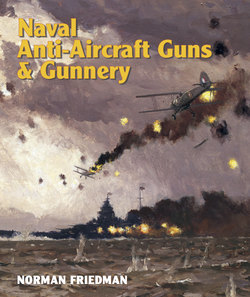Читать книгу Naval Anti-Aircraft Guns and Gunnery - Norman Friedman - Страница 8
На сайте Литреса книга снята с продажи.
ОглавлениеACKNOWLEDGEMENTS
Many friends helped me in this project, research for which extended back many years to my earlier work on US naval weapons, on naval radars, and then on various classes of warships, particularly US and British. As with my earlier books, this one is based largely on archival sources. The official archives involved, to the staffs of all of which I owe great thanks, were the US National Archives (largely Archives II at College Park), the British National Archive (which I still think of as the Public Record Office [PRO]), the Royal Naval Historical Branch and Admiralty Library (and particularly Admiralty Librarian Ms Jennie Wraight), the Royal Australian Navy Sea Power Centre (particularly its chief Dr David Stevens and his assistant John Perryman), the US Navy Department Library at the Washington Navy Yard (particularly the special collections, and particularly by head librarian Glenn Helm), the US Navy Operational Archives at the Washington Navy Yard, the Archive at the Naval War College in Newport (particularly archivist Dr Evelyn Cherpak), the Brass Foundry outstation of the National Maritime Museum (particularly its head Jeremy Michell and his assistant Andrew Choong), the French defence archive at Vincennes (which now incorporates the old Service Historique de la Marine, where I did the research), and the French DGA archive at Chatellerault. I also enjoyed the hospitality of the library associated with the Science Museum in London, and that of the reference branch of the New York Public Library. For photographs my main institutional sources were the still photo collection at Archives II, the collection of the Naval Historical and Heritage Center (for which I am particularly grateful to its curator emeritus, Chuck Haberlein; I also wish to thank his successor Robert Hanshew, now no longer there), and the photo library at the US Naval Institute (for assistance with which I particularly wish to thank its curator, Janis Jorgensen). Dr Stevens and Mr Perryman in particular provided some invaluable illustrations. Richard Pekelney of the Historic Naval Ships Association provided essential material, both textual and illustrative. Richard Gimblett, the official Canadian naval historian, organised assistance with photographs of weapons employed by the RCN. I would like to thank Richard Sanderson of the Canadian Maritime Command Museum at Halifax (which maintains the corvette Sackville), Bill Wilson and Stephen Magusiak of the Alberta Military Museums (described as the best collection of naval weapons in Canada), and Luc J A Portelance of the RCN weapons directorate. I much appreciate illustrations and other assistance provided by A D Baker III, Christopher C Wright (editor of Warship International), Dr Raymond Cheung, Chris Carlson, Christoph Kluxen, Rick E Davis, Dr Mauricio Brescia, Lieutenant Commander Erminio Bagnasco, Gino Chesi (president of the Gruppo Cultura Navale of Bologna), Lieutenant Commander David Hobbs RN (ret, and formerly Curator of the Fleet Air Arm Museum at Yeovilton), John A Roberts, John H Lambert, John Jordan, Ian Buxton, Tracy White and Mirosław Skwiot. Mr Baker offered many invaluable insights, some of which were derived from his own experience as an officer using the 3in/50 automatic gun. Stephen McLaughlin generously translated some Russian material. David Dickson provided translated Japanese documents which proved crucial in understanding Japanese tactical thinking. Alan Raven offered insights from his forthcoming operational history of British cruisers during the Second World War. Dr Jon Sumida provided Barr & Stroud documents which shed considerable light on the company’s early anti-aircraft work and its connection with the Italian and Japanese navies, and to a lesser extent its entirely involuntary connection with the German navy. I am also grateful for material and comments provided by Vince O’Hara and by Enrico Cernuschi. Alexandre Sheldon-Dupleix, a French official naval historian, helped with French material and with a visit to the armament archive at Chatellerault. My publisher Robert Gardiner deserves special thanks for his patience and his enthusiasm in shepherding so complicated a book through production. Everyone involved helped make this a better and more accurate book. I remain responsible for errors and other shortcomings.
I could never have undertaken this project without the loving support of my wife Rhea. Over the decades, her sustained encouragement, both of my research (including considerable travel) and of my writing, has made my work possible. I hope the result justifies her faith in it.
Improved anti-aircraft effectiveness is traceable to a host of improvements, all of which are evident on board Missouri, shown in Tokyo Bay, 27 August 1945. One was improved medium-range anti-aircraft fire, achieved using better computers, radars and proximity fuses. Another was the sheer volume of automatic fire, represented in this case by numerous quadruple Bofors guns and twin Oerlikons. Yet another was the rise of effective short-range directors for both automatic weapons and medium-range guns firing at short ranges, such as the Mk 57s (with their radar dishes) visible around the after fire-control tower. When this ship was designed, the US Navy’s standard for future automatic anti-aircraft fire was four quadruple 1.1in guns and eight single 0.50-calibre machine guns. In 1945 Missouri had no fewer than twenty quadruple Bofors, each of them far more powerful than the 1.1in weapon planned before the war (not all of them are visible here). They included turret-top mountings and pairs of mountings forward and abaft the main battery turrets, both of which had been rejected before the war. Mounts near the main battery turrets would have been rejected because they were vulnerable to the blast of those turrets. This sort of expansion was possible because of the considerable reserve buoyancy and stability of US warships.
